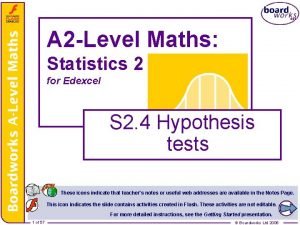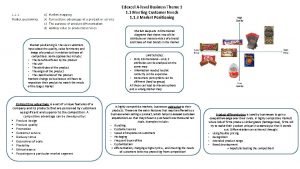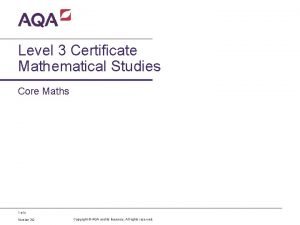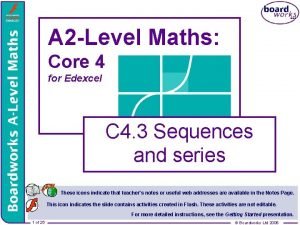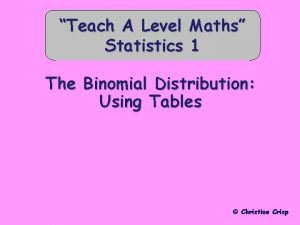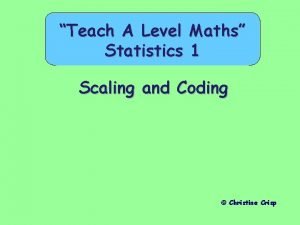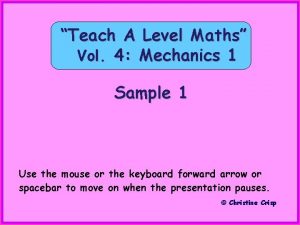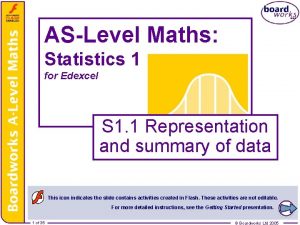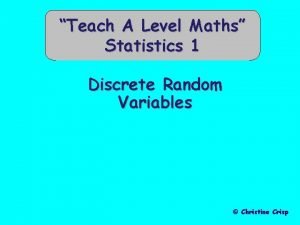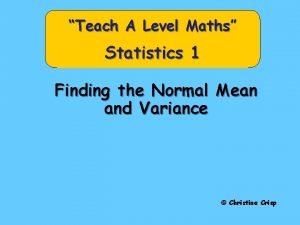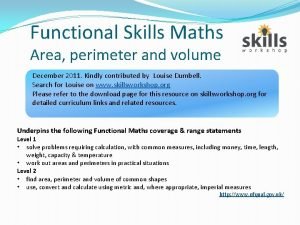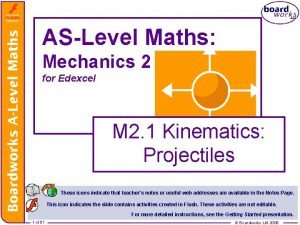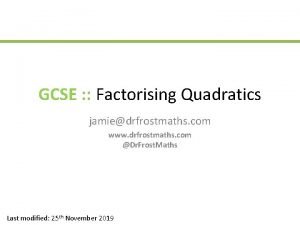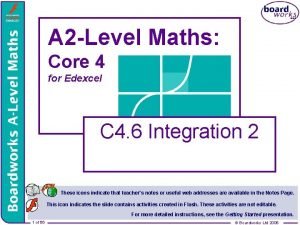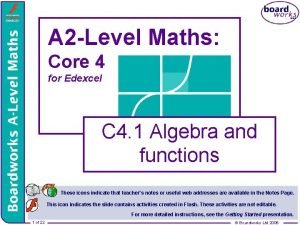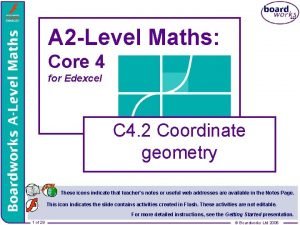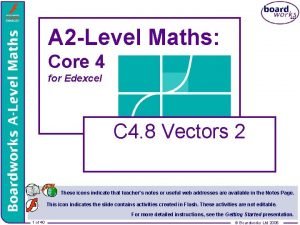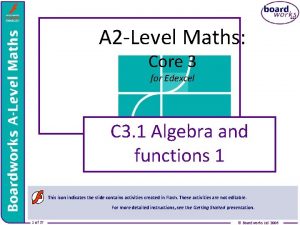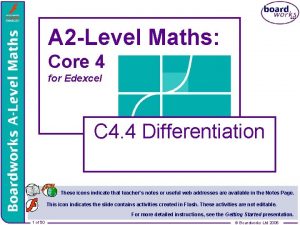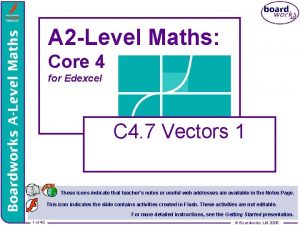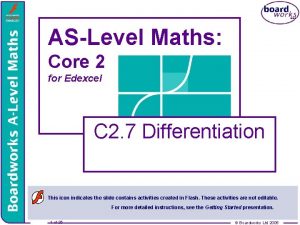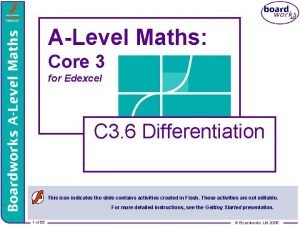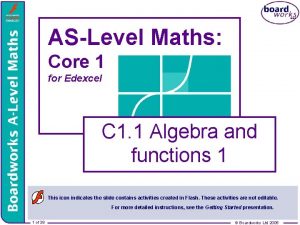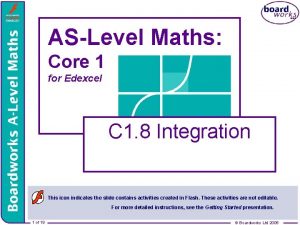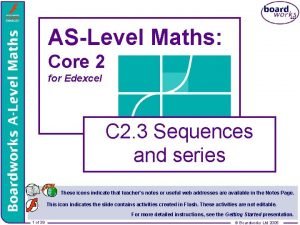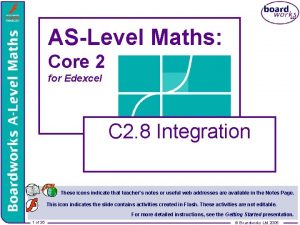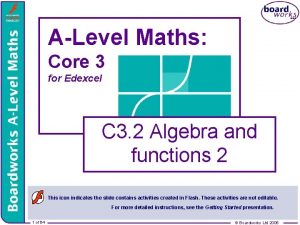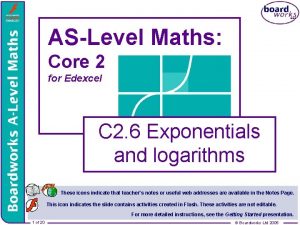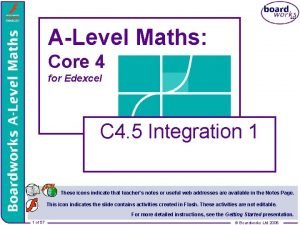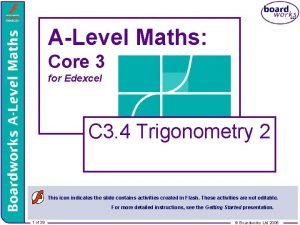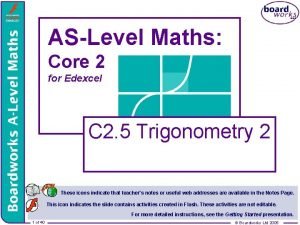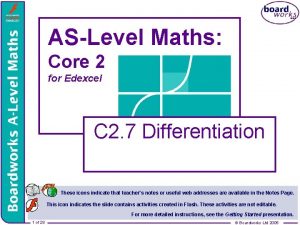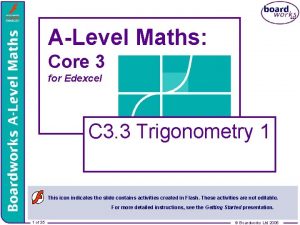A 2 Level Maths Core 4 for Edexcel






















- Slides: 22

A 2 -Level Maths: Core 4 for Edexcel C 4. 1 Algebra and functions This icon indicates the slide contains activities created in Flash. These activities are not editable. For more detailed instructions, see the Getting Started presentation. 1 of 22 © Boardworks Ltd 2006

Contents Partial fractions Denominators with distinct linear factors Denominators with a repeated linear factor Improper fractions 2 of 22 © Boardworks Ltd 2006

Partial fractions We know that two or more algebraic fractions can be added or subtracted to give a single fraction. For example: Now, suppose we want to reverse the process. In other words, suppose we are given and asked to express it as a sum of two separate fractions. 3 of 22 © Boardworks Ltd 2006

Two distinct linear factors This process is called expressing fractions. in partial For example: Express in partial fractions. The first step is to set up an identity. The denominator of this fraction has two distinct linear factors so let where A and B are constants to be found. 4 of 22 © Boardworks Ltd 2006

Two distinct linear factors 1 There are now two ways to continue: using suitable substitutions, by equating coefficients. To solve by substitution, we choose values of x that make the brackets zero. 5 of 22 © Boardworks Ltd 2006

Two distinct linear factors Here substitute x = – 1 into 1 : Now substitute x = 3 into 1 : Therefore 6 of 22 © Boardworks Ltd 2006

Contents Denominators with distinct linear factors Partial fractions Denominators with distinct linear factors Denominators with a repeated linear factor Improper fractions 7 of 22 © Boardworks Ltd 2006

Two distinct linear factors Express in partial fractions. Let This can be simplified by multiplying through by (3 x – 2)(2 x – 1): This time if we use the substitution method we’ll have to substitute fractional values for x. Let’s multiply out the brackets and equate coefficients instead. 8 of 22 © Boardworks Ltd 2006

Two distinct linear factors Equate the coefficients of x: 1 Now equate the constants: 2 1 + (2 × 2 ) gives: Substitute this into 1 to find A: Therefore 9 of 22 © Boardworks Ltd 2006

Three distinct linear factors Express as a sum of partial fractions. This time we have three distinct linear factors, so: Let Multiply through by (x – 3)(x +1)(2 x +1): 1 To find A, substitute x = 3 into 1 : 10 of 22 © Boardworks Ltd 2006

Three distinct linear factors We can find B by substituting x = – 1 into 1 : We can now find C either by substituting x = the method of equating coefficients. 11 of 22 or by reverting to © Boardworks Ltd 2006

Three distinct linear factors To avoid awkward arithmetic involving fractions, let’s form an equation in C by equating the constant terms in 1. 1 We could also equate the coefficients of x 2 or x. Therefore 12 of 22 © Boardworks Ltd 2006

Contents Denominators with a repeated linear factor Partial fractions Denominators with distinct linear factors Denominators with a repeated linear factor Improper fractions 13 of 22 © Boardworks Ltd 2006

Denominators with a repeated linear factor Suppose we wish to express in partial fractions. This is an example of a fraction whose denominator contains a repeated linear factor. In this case, the partial fractions will be of the form: We can now find A, B and C using a combination of substitution and equating the coefficients. 14 of 22 © Boardworks Ltd 2006

Denominators with a repeated linear factor 1 Substitute x = – 4 into 1 : Substitute x = 3 into 1 : To find B we can switch to the method of comparing coefficients. 15 of 22 © Boardworks Ltd 2006

Denominators with a repeated linear factor Equate the coefficients of x 2 in 1 : But A = 2 so: Therefore Express as a sum of partial fractions. Let 16 of 22 © Boardworks Ltd 2006

Denominators with a repeated linear factor Multiply through by x 2(4 – x): 1 Substitute x = 0 into 1 : Substitute x = 4 into 1 : 17 of 22 © Boardworks Ltd 2006

Denominators with a repeated linear factor We can find A by comparing the coefficients of x 2. But C = 4 so: Therefore 18 of 22 © Boardworks Ltd 2006

Contents Improper fractions Partial fractions Denominators with distinct linear factors Denominators with a repeated linear factor Improper fractions 19 of 22 © Boardworks Ltd 2006

Improper fractions Remember, an algebraic fraction is called an improper fraction if the degree of the polynomial is equal to, or greater than, the degree of the denominator. To express an improper fraction in partial fractions we start by expressing it in the algebraic equivalent of mixed number form. Any proper fractions contained in this form can then be expressed in partial fractions. Express in partial fractions. We can either use long division to divide 2 x 2 – 3 x + 13 by x 2 – 2 x – 15 or we can set up an identity as follows: 20 of 22 © Boardworks Ltd 2006

Improper fractions Start by factorizing the denominator. The numerator and the denominator are both of degree 2 and so they will divide to give a constant, A. The part that is a proper fraction will have two distinct linear factors. So we can let Multiply through by (x + 3)(x – 5): 1 21 of 22 © Boardworks Ltd 2006

Improper fractions Substitute x = – 3 into 1 : Substitute x = 5 into 1 : We can find A by equating the coefficients of x 2 in 1. Therefore 22 of 22 © Boardworks Ltd 2006
 Edexcel a level maths hypothesis testing
Edexcel a level maths hypothesis testing Pie charts gcse questions
Pie charts gcse questions Gcse edexcel english literature past papers
Gcse edexcel english literature past papers Edexcel a level business distribution
Edexcel a level business distribution Theme 1 business a level edexcel
Theme 1 business a level edexcel Fermi estimation core maths
Fermi estimation core maths Core 4 maths
Core 4 maths The brittle, rocky outer layer of earth
The brittle, rocky outer layer of earth Earth mantle definition
Earth mantle definition Basic layers of the earth
Basic layers of the earth Core capabilities and core rigidities
Core capabilities and core rigidities A level binomial distribution
A level binomial distribution Coding statistics a level
Coding statistics a level Connected particles a level maths
Connected particles a level maths How to find the length of confidence interval
How to find the length of confidence interval Progress test example
Progress test example Interpolation a level maths
Interpolation a level maths Discrete random variable a level maths
Discrete random variable a level maths A level statistics
A level statistics Functional skills maths level 1 area and perimeter
Functional skills maths level 1 area and perimeter Projectiles a level maths
Projectiles a level maths Maths literacy level 3
Maths literacy level 3 Www.drfrostmaths.com answers
Www.drfrostmaths.com answers
